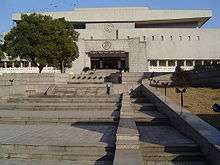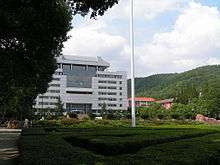Changsha
Changsha ( ʈʂʰɑŋʂa; simplified Chinese: 长沙; traditional Chinese: 長沙; pinyin: Chángshā ) is the capital of Hunan province, south central China. It covers 11,819 km2 (4,563 sq mi) and is bordered by Yueyang and Yiyang to the north, Loudi to the west, Xiangtan and Zhuzhou to the south, Yichun and Pingxiang of Jiangxi province to the east. According to 2010 Census,Changsha had 7,044,118 residents, constituting 10.72% of the province's population.[2]
Geographically Changsha is located in the Xiang river valley plain, bordering on Luoxiao Mountains on the east, Wuling Mountains on the west, edging in Dongting Lake on the north and bounded on the south by Hengshan Mountains. It has a moist monsoon climate of the subtropical zone. The average annual air temperature is 16.8–17.3 °C and the rainfall 1,358.6–1,552.5 mm.[3]
Changsha is a famous historical and cultural city with a history of over 3,000 years.[4] Changsha is famous for that it was the capital of Changsha State in the Han Dynasty (206 BC – 220 AD), and the capital of Chu State (907–951) in Ten Kingdoms period. The lacquerware and Silk Texts recovered from Mawangdui (2nd century BC) there are an indication of the richness of local craft traditions. In 1904 Changsha was opened to foreign trade, and large numbers of Europeans and Americans settled there. Changsha was the site of Mao Zedong's conversion to communism. It was also the scene of major battles in the Sino-Japanese War (1931–1945) and was briefly occupied by the Japanese. Nowadays, Changsha is an important commercial, manufacturing and transportation center in China.
Etymology
The origins of the name "Changsha" are lost in antiquity. The name first appears in the 11th century BC, during the reign of King Cheng of the Zhou dynasty: a vassal lord from the Changsha area sent a type of softshell turtle known as "Changsha softshell turtle" (simplified Chinese: 长沙鼈; traditional Chinese: 長沙鼈; pinyin: Chángshā biē) to the Zhou king as a tribute. In the 2nd century AD, historian Ying Shao wrote that the Qin dynasty use of the name Changsha for the area was a continuance of its old name.[5]
History
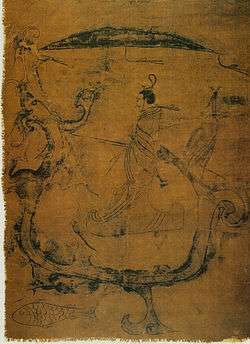
During the 1st millennium BC, Changsha was the centre of the southern part of the Yangtze River valley state of Chu. In 1935–36 some Chu graves excavated nearby produced important evidences of Chu culture; for instance, the Chu Silk Manuscript. The city is sometimes called Qingyang (simplified Chinese: 青阳; traditional Chinese: 青陽; pinyin: Qīngyáng) in Warring States period texts.
Under the Qin dynasty (221–206 BC) it became a staging post for Qin expeditions into Guangdong province. By 202 BC it was already a fortified city. During the Han dynasty it was also the capital of Changsha Kingdom, an imperial fiefdom of the Han.
From Han times (206 BC – AD 220) it was named Linxiang County and was the seat of the Changsha commandery. The county was renamed Changsha in 589, when it became the administrative seat of Tan prefecture. It lost some importance during this period, however, because traffic from Guangdong was mostly diverted up the Gan River valley in Jiangxi.
The celebrated Mawangdui tombs of the Han dynasty were constructed between 186 and 165 BC. The earliest tomb (no. 2), when excavated in the 1970s, was seen to have preserved the corpse of Lady Xin Zhui in a surprisingly good condition. Also found in the tomb were the earliest versions of the Dao De Jing, the main text of Taoism, among many other historical documents.
During the Three Kingdoms period, Changsha was a much-fought-over territory. During the Sui Dynasty, Changsha was a county and under the Tang was known as Tanzhou.
After the fall of the Tang dynasty (618–907), Changsha became the capital of the independent Chu state and later fell to the Later Tang dynasty (923–937). Between 750 and 1100, as Changsha became an important commercial city, the population of the area increased tenfold.
Under the Ming (1368–1644) and Qing (1644–1911/12) dynasties, Changsha was made a superior prefecture and from 1664 onward was the capital of Hunan, prospering as one of China's chief rice markets. During the Taiping Rebellion, the city was besieged by the rebels (1854) but never fell; it then became the principal base for the suppression of the rebellion. It was opened to foreign trade in 1904. Further development followed the opening of the railway to Hankou in Hubei province in 1918, which was later extended to Guangzhou in Guangdong province in 1936. Although Changsha's population grew, the city remained primarily commercial in character and before 1937 had little industry apart from some small cotton-textile, glass, and nonferrous-metal plants and handicraft enterprises.
Yuelu Academy was founded in AD 976 (during the period of the Song dynasty). It was destroyed by war in 1127 and was rebuilt in 1165 (during the Southern Song dynasty). The celebrated philosopher Zhu Xi taught at the Academy in 1165. It was again destroyed, this time by the Mongols, but was restored in the late 15th century (Ming dynasty). Early 19th century graduates of the academy formed what one historian called a "network of messianic alumni", including Zeng Guofan, architect of the Tongzhi Restoration,[6] and Cai E, a major leader in the defense of the Republic of China.[7] (In 1903 the academy became Hunan High School. The modern day Hunan University is a descendant of the academy. The architecture of some of the buildings of the university was restored from 1981 to 1986, presumably according to their original Song design.)
In 1852 Taiping forces laid a siege on Changsha through 3 months, but they gave up the offensive thereafter and moved on toward Wuhan.
Then, the 1903 Treaty of Shanghai between the Qing dynasty and Japan opened the city to foreign trade. Consequently, factories, churches and schools were built. A college was started by Yale University bachelors, which later became a medical center named Xiangya and a secondary school named the Yali School.
Mao Zedong, the founder of the People's Republic of China, began his political career in Changsha. He was a student at the Hunan Number 1 Teachers' Training School from 1913 to 1918. He later returned as a teacher and principal from 1920 to 1922. The school was destroyed during the Chinese Civil War but has since been restored. The former office of the Hunan Communist Party Central Committee where Mao Zedong once lived is now a museum that includes Mao's living quarters, photographs and other historical items from the 1920s.
Until May 1927, communist support remained strong in Changsha before the massacre carried out by the right-wing faction of the KMT troops. The faction owed its allegiance to Chiang Kai-shek during its offensive against the KMT's left-wing faction under Wang Jingwei, who was then allied closely with the Communists. The purge of communists and suspected communists was part of Chiang's plans for consolidating his hold over the KMT, weakening Wang's control, and thereby over the entire China. In a period of twenty days, Chiang's forces killed more than ten thousand people in Changsha and its outskirts.
During the Second Sino-Japanese War (1937–45), the strategic location of Changsha made it the focus of four campaigns by the Japanese to capture it from the hands of the Chinese Nationalists: these campaigns were the 1st Changsha,[8] the 2nd Changsha, the 3rd Changsha, and the 4th Changsha. The city was able to repulse the first three attacks, thanks to Xue Yue's leadership, but ultimately fell into Japanese hands in 1944 for a year until the Japanese were defeated in a counterattack and forced to surrender.[9][10] Before these Japanese campaigns, the city was already virtually destroyed by the 1938 Changsha Fire, which was a deliberate fire ordered by Kuomintang commanders who mistakenly feared the city was about to fall to the Japanese; Generalissimo Chiang Kai-shek had suggested that the city should be burned so that the Japanese force would gain nothing after entering it.[11]
The city later became the territory of then-expanding Communist China when it was finally completed in 1949 after the Kuomintang were driven to Taiwan.
Geography
| Changsha | ||||||||||||||||||||||||||||||||||||||||||||||||||||||||||||
|---|---|---|---|---|---|---|---|---|---|---|---|---|---|---|---|---|---|---|---|---|---|---|---|---|---|---|---|---|---|---|---|---|---|---|---|---|---|---|---|---|---|---|---|---|---|---|---|---|---|---|---|---|---|---|---|---|---|---|---|---|
| Climate chart (explanation) | ||||||||||||||||||||||||||||||||||||||||||||||||||||||||||||
| ||||||||||||||||||||||||||||||||||||||||||||||||||||||||||||
| ||||||||||||||||||||||||||||||||||||||||||||||||||||||||||||
Changsha is located between 111° 53'–114° 05' E longitude and 27° 51'–28° 40' N latitude, situated in east central Hunan. Its terrain is high in the west and low in the east. There are many mountainous areas in the west and in the north. The Xiang River flows south to northwest; the 296-metre (971 ft) high Mount Yuelu is in the west; and Liuyang River and Laodao River are in the east.
Changsha's neighboring areas include: cities and counties and a district of Hunan including Tonggu County, Pingjiang County, Miluo City, Xiangyin County of Yueyang, Taojiang County, Heshan District, Anhua County of Yiyang, Lianyuan City of Loudi, Zhuzhou County, Liling City of Zhuzhou, Xiangtan County, Xiangxiang City of Xiangtan; and cities and counties of Jiangxi including Wanzai County, Yichun City, and Pingxiang City.
Climate
Changsha experiences a humid subtropical climate (Köppen Cfa), with annual average temperature being at 17.03 °C (62.7 °F), with a mean of 4.6 °C (40.3 °F) in January and 29.0 °C (84.2 °F) in July. Average annual precipitation is 1,331 millimetres (52.4 in), with a 275-day frost-free period. With a monthly possible-sunshine percentage ranging from 19% in March to 57% in August, the city receives 1,545 hours of bright sunshine annually. The four seasons are distinct. The summers are long and very hot, with heavy rainfall, and autumn is comfortable and is the driest season. Winter is chilly and overcast with lighter rainfall more likely than downpours; cold snaps occur with temperatures occasionally dropping below freezing. Spring is especially rainy and humid with the sun shining less than 30% of the time.The minimum temperature ever recorded since 1951 at the current Wangchengpo Weather Observing Station was −12.0 °C (10.4 °F), recorded on 9 February 1972. The maximum was 40.6 °C (105.1 °F) on 13 August 1953 and 2 August 2003 [the unofficial record of 43.0 °C (109.4 °F) was set on 10 August 1934].
| Climate data for Changsha Wangchengpo望城坡 57687 Weather Observing Station (1971–2013) | |||||||||||||
|---|---|---|---|---|---|---|---|---|---|---|---|---|---|
| Month | Jan | Feb | Mar | Apr | May | Jun | Jul | Aug | Sep | Oct | Nov | Dec | Year |
| Record high °C (°F) | 26.7 (80.1) |
30.4 (86.7) |
32.7 (90.9) |
36.1 (97) |
36.3 (97.3) |
38.2 (100.8) |
39.7 (103.5) |
40.6 (105.1) |
38.2 (100.8) |
34.8 (94.6) |
30.9 (87.6) |
24.9 (76.8) |
40.6 (105.1) |
| Average high °C (°F) | 8.7 (47.7) |
9.7 (49.5) |
14.7 (58.5) |
21.3 (70.3) |
26.1 (79) |
29.9 (85.8) |
33.7 (92.7) |
33.3 (91.9) |
28.3 (82.9) |
23.1 (73.6) |
17.2 (63) |
11.3 (52.3) |
21.4 (70.6) |
| Daily mean °C (°F) | 4.7 (40.5) |
6.2 (43.2) |
10.9 (51.6) |
16.8 (62.2) |
21.6 (70.9) |
25.9 (78.6) |
29.3 (84.7) |
28.7 (83.7) |
24.2 (75.6) |
18.5 (65.3) |
12.5 (54.5) |
7.1 (44.8) |
17.2 (62.97) |
| Average low °C (°F) | 1.6 (34.9) |
3.4 (38.1) |
7.8 (46) |
13.7 (56.7) |
18.4 (65.1) |
22.4 (72.3) |
25.3 (77.5) |
24.9 (76.8) |
20.3 (68.5) |
14.7 (58.5) |
9.0 (48.2) |
3.4 (38.1) |
13.7 (56.7) |
| Record low °C (°F) | −9.5 (14.9) |
−12.0 (10.4) |
−2.3 (27.9) |
1.9 (35.4) |
8.9 (48) |
13.1 (55.6) |
19.7 (67.5) |
16.7 (62.1) |
11.8 (53.2) |
2.4 (36.3) |
−2.8 (27) |
−10.3 (13.5) |
−12 (10.4) |
| Average precipitation mm (inches) | 66.1 (2.602) |
95.2 (3.748) |
128.5 (5.059) |
207.2 (8.157) |
178.5 (7.028) |
202.4 (7.969) |
93.0 (3.661) |
107.0 (4.213) |
56.8 (2.236) |
84.2 (3.315) |
71.2 (2.803) |
41.2 (1.622) |
1,331.3 (52.413) |
| Average precipitation days (≥ 0.1 mm) | 13.6 | 14.0 | 17.8 | 18.8 | 16.3 | 13.3 | 9.7 | 9.9 | 9.8 | 11.1 | 10.2 | 9.4 | 153.9 |
| Average relative humidity (%) | 83 | 85 | 85 | 84 | 83 | 84 | 77 | 79 | 81 | 81 | 80 | 79 | 81.8 |
| Mean monthly sunshine hours | 76.2 | 63.0 | 69.4 | 88.3 | 122.8 | 144.8 | 238.3 | 229.6 | 160.0 | 133.4 | 115.7 | 103.2 | 1,544.7 |
| Percent possible sunshine | 24 | 20 | 19 | 23 | 29 | 35 | 56 | 57 | 43 | 38 | 36 | 32 | 35 |
| Source: China Meteorological Administration | |||||||||||||
Administration
The city of Changsha has direct jurisdiction over 6 districts, 1 county-level city, and 2 counties:
| Map | |||||
|---|---|---|---|---|---|
| Subdivision | Simplified Chinese | Pinyin | Pop. (2010 Census) |
Area (km²) | Dens. (/km²) |
| City Proper | |||||
| Furong District | 芙蓉区 | Fúróng Qū | 523,730 | 42 | 12,470 |
| Tianxin District | 天心区 | Tiānxīn Qū | 475,663 | 74 | 6,428 |
| Yuelu District | 岳麓区 | Yuèlù Qū | 801,861 | 552 | 1,453 |
| Kaifu District | 开福区 | Kāifú Qū | 567,373 | 187 | 3,034 |
| Yuhua District | 雨花区 | Yǔhuā Qū | 725,353 | 114 | 6,363 |
| Suburban and rural | |||||
| Wangcheng District | 望城区 | Wàngchéng Qū | 523,489 | 970 | 540 |
| Liuyang City | 浏阳市 | Liúyáng Shì | 1,278,928 | 4,999 | 256 |
| Changsha County | 长沙县 | Chángshā Xiàn | 979,665 | 1,997 | 491 |
| Ningxiang County | 宁乡县 | Níngxiāng Xiàn | 1,168,056 | 2,906 | 402 |
Transportation
Changsha is well connected by roads, river, rail, and air transportation modes, and is a regional hub for industrial, tourist, and service sectors.
Public transport
The city's public transportation system consists of an extensive bus network with over a hundred lines as well as taxis.
Metro Rail
Changsha Metro is planning a 6-line network.[12] Line 2 opened on 29 April 2014[13] with 20 stations for Line 1[12] now open on 28 June 2016.[14][15] A further four lines are planned for construction before the year 2025.[13] Line 3 will run southwest–northeast and will be 33.4 kilometres (20.8 mi) long. Line 4 will run northwest-southeast and will be 29.1 kilometres (18.1 mi) long.[16] A maglev link running 16.5 kilometres (10.3 mi) between Changsha South station and Changsha airport was opened in April 2016, with a construction cost of €400m.[13][17][18]
Roads
National Highways 107 and 319, as well as Changsha–Zhuzhou–Xiangtan Express Way, connect the Changsha metro area nationally. There are three main bus terminals in Changsha: South Station, East Station and West Station, dispatching long- and short-haul trips to cities within and outside Hunan Province.
River
Changsha is surrounded by major rivers, including the Xiangjiang (湘江), the Liuyang River (浏阳河), the Xiangjiang River (靳江河), the Weishui (沩水), Longwanggang River (龙王港河), and the Laodao River (捞刀河). Ships transport mainly goods from Xianing port located in North Changsha domestically and internationally.
Rail
Changsha Railway Station is located in the city center and provides express and regular services to most cities in China via the Beijing–Guangzhou and Shimen–Changsha Railways. The Changsha South Railway Station is a new high speed railway station, located in Yuhua district on the Beijing–Guangzhou High-Speed Railway (as part of the planned Beijing–Guangzhou–Shenzhen–Hong Kong High-Speed Railway). The station with 8 platforms[19] was finally opened on 26 December 2009.[20] Since then the passenger volume has increased greatly.[21] The Hangzhou-Changsha-Huaihua sector of the Shanghai-Changsha-Kunming high-speed railway entered service in 2014.
Air

Changsha Huanghua International Airport is a regional hub for China Southern Airlines. The airport severs daily flights to major cities in China, including Beijing, Shanghai and Guangzhou, as well as Hong Kong, Macau and Taipei. Other major airlines also provide daily service between Changsha and other domestic and international destinations.The airport provides direct flights to 45 major international cities including Los Angeles, Singapore, Seoul, Pusan, Osaka, Tokyo, Kuala Lumpur, Frankfurt as well as Sydney.[22] As of August 5, 2016, the airport daily handled 70011 people.[23]
Economy
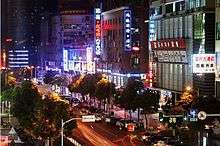
Changsha's population nearly tripled between the start of its rebuilding in 1949 and the early 1980s. The city is now a major port, handling rice, cotton, timber, and livestock, and is also a collection and distribution point on the railway from Hankou to Guangzhou. It is a centre of rice milling and also has oil-extraction, tea and tobacco production, and meat-processing plants. Its textile industry produces cotton yarn and fabrics and engages in dyeing and printing. Agricultural chemicals and fertilizers, farm implements, and pumping machinery are also produced.
Changsha has a large thermal generating station linked by a power grid with the nearby industrial centres of Zhuzhou and Xiangtan; the three cities were designated in the 1970s as the nucleus of a major industrial complex. In the 1960s there was some development of heavy industry. The manufacture of machinery, especially machine tools and precision tools, became important, and Changsha became a center of China's aluminum industry. The city also has cement, rubber, ceramic, and papermaking plants and is a centre for many types of traditional handicrafts, producing Xiang embroidery, leather goods, umbrellas, and buttons. Coal is mined in the vicinity.
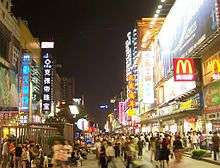
Changsha is one of China's 20 most "economically advanced" cities. In 2008, Changsha's nominal GDP was ¥300.1 billion (US$43 billion), a year-on-year growth of 15.1% from the previous year. Its per capita GDP was ¥45,765 (US$6,589).[24] Its GDP grew at an average of 14% per year from 2001 to 2005, compared to the national average of 9% in the period. As of 2005, the service sector generated roughly around 49% of Changsha's GDP, up 112% from 2001 figures, leading to a disposable income for urban residents of 12,343 RMB annually. This growth is expected to continue driving the city's economic growth.[25] The manufacturing and construction sectors have grown relatively steadily, growing 116% during 2001-2005. The primary sector, including agriculture, forestry, animal husbandry, and fishery, has grown slightly over this same period. In addition, the consumer market has grown dramatically along with income levels, with the minimum salary level at 600 RMB per month in comparison to Beijing's at 640 RMB or Shanghai's at 750 RMB per month.[26] Urban residents in 2005 had an average income of about US$1,500, 15% higher than the national average and up 10% from 2001 figures.[27]
Changsha has attracted a substantial level of foreign investment. In 2005, for example, nearly US$1 billion worth of foreign direct investment (FDI) poured into the city, mainly in hi-tech, manufacturing, food production, and services. This figure is up 40% from 2001. 59% of the total FDI has come from Hong Kong, South Korea, Singapore, and Japan; 28% has come from the Americas and 9% from Europe.[28] By the end of 2008 more than 500 foreign companies had made over US$10 million worth of investments in Changsha.[29] Changsha had total retail sales of 74 RMB billion in 2006.[30]
But rapid economic growth has made environmental pollution a serious problem in Changsha, caused by rapidly increasing numbers of private cars, widespread construction sites, and numerous industrial facilities on the outskirts of the city.

Sky City
On 20 July 2013, the Sky City skyscraper broke ground.[31] A groundbreaking ceremony of the building was held. At completion it will be the new world's tallest skyscraper. The planned final height is 838 meters with 220 floors.[31] The Broad Sustainable Building company, which specializes in the rapid construction of large buildings, planned to complete construction in early 2014.[31][32][33] However, the project was halted by the authorities on 24 July 2013 due to its having started construction without prior law permits.[34][35] Some experts also questioned the safety of the 838-meter skyscraper's being built in only 7 months.[36] On 4 September 2013, China.com.cn reported that the project had begun environmental assessment for obtaining the official planning approval for the project.[37] By 30 October the building was already in the final approval phase.[38]
Changsha National Economic and Technical Development Zone
The Changsha National Economic and Technology Development Zone was founded in 1992. It is located east of Changsha. The total planned area is 38.6 km2 (14.9 sq mi) and the current area is 38.6 km2 (14.9 sq mi). Near the zone are National Highways 319 and 107 as well as the G4 Beijing–Hong Kong–Macau Expressway. The zone is also very close to Changsha's downtown area and the railway station, while the distance between the zone and the city's airport is a mere 8 km (5.0 mi). The major industries in the zone include the high-tech industry, the biology project technology industry, and the new material industry.[39]
Culture and sports
In recent years, Changsha has become an important creative center for the TV and entertainment arts, with its many TV stations producing some of the most popular programs in China, including Super Girl. These programs have also brought a new entertainment industry into the city, which includes singing bars, dance clubs, theater shows, as well as related businesses including hair salons, fashion stores, and shops for hot spicy snacks at night (especially during summer). While Changsha has developed into an entertainment hub, the city has also become increasingly westernized and has attracted a growing number of foreigners.
Changsha is home to the Lei Feng Memorial (simplified Chinese: 雷锋纪念馆; traditional Chinese: 雷鋒紀念館; pinyin: Léi Fēng Jìniànguǎn).
In May 2008, the BBC broadcast, as part of its Storyville documentary series, the four-part The Biggest Chinese Restaurant in the World, which explored the inner workings of the 5,000-seating-capacity West Lake Restaurant (Xihu Lou Jiujia) in Changsha.
Changsha has one of China's largest multi-purpose sports stadiums—Helong Stadium, with 55,000 seats. The stadium was named after the Communist military leader He Long. It is the home ground of local football team Hunan Billows F.C., which plays in China League One. The more modest 6,000-seat Hunan Provincial People's Stadium, also located in Changsha, is used by the team for their smaller games.[40]
Education
Colleges and universities
Changsha is the seat of many ancient schools and academies.[41] It is the site of the Hunan Medical University (1914) and has several colleges and institutes of higher learning.
National
Public
- Hunan Normal University
- Hunan Agricultural University
- Hunan First Normal University
- Hunan University of Commerce
- Hunan University of Traditional Chinese Medicine
- Central South University of Forestry and Technology
- Changsha University
- Changsha Medical University
- Changsha University of Science and Technology
Note: Institutions without full-time bachelor programs are not listed.
International schools
Notable high schools
- Yali High School
- Changjun High School
- The First High School of Changsha
- The High School Attached to Hunan Normal University
Notable Primary Schools
- Yanshan Primary School
- Yucai Primary School
- Shazitang Primary School
- Yuying Primary School
- Qingshuitang Primary School
Notable people
Changsha and its surrounding areas is the birthplace of:
- Huang Xing – Chinese revolutionary leader and the first army commander-in-chief of the Republic of China
- Tian Han – author of the lyrics to "March of the Volunteers", the PRC national anthem
- Liu Shaoqi – President of the People's Republic of China (PRC), 1959–1968
- Qi Xueqi – general in the Kuomintang (KMT)
- Yang Kaihui – Chairman Mao Zedong's first wife
- Hu Yaobang – General Secretary of the Chinese Communist Party (1980–1987)
- Lei Feng – People's Liberation Army soldier and cultural icon
- Zhu Rongji – PRC Premier, 1997–2002
- Liang Heng – writer and literary scholar
- Tan Dun – contemporary composer (soundtracks for the films Crouching Tiger, Hidden Dragon and Hero)
- Tang Sulan – writer and politician.
- Shen Wei - dancer and the choreographer of modern dance for the 2008 Beijing Olympics
- Xiong Ni – Olympic male diver and gold medalist
- Li Xiaopeng – Olympic male gymnast and gold medalist
- Liu Xuan - Olympic female gymnast and gold medalist
- Meng Jia – member of the Korean-Chinese girl group Miss A
- Zhang Yixing (Lay) – a member of South Korean-Chinese boy band under SM entertainment, EXO
- Tong Mingqian – disgraced Hunan provincial official convicted of dereliction of duty
People associated with Changsha
- Jia Yi – Han dynasty poet and statesman
- Zhang Zhongjing – Han dynasty physician
- Zhu Xi – Song dynasty Neo-Confucian scholar
- Qi Baishi – painter
- Mao Zedong – first President of the People's Republic of China
- Yuan Longping – agricultural scientist
Astronomy
Changsha was represented by the star Zeta Corvi in a Chinese constellation.[42]
See also
- 1938 Changsha Fire
- Cathedral of the Immaculate Conception (Changsha)
- List of twin towns and sister cities in China
References
- ↑ "Statistical Communiqué of Changsha on the 2015 National Economic and Social Development (Chinese·中文)".
- ↑ "湖南省第六次全国人口普查 - 湖南省第六次全国人口普查主要数据公报[1]". Retrieved 29 October 2016.
- ↑ Changsha.gov: Geography of Changsha
- ↑ The Complete list of national famous historical and cultural cities (promulgated by State Council of China): Chinese-EconomicsNet.com (2015-9-1) or Netease (2015-9-1)
- ↑ Zhongguo gujin diming dacidian 中国古今地名大词典 [Dictionary of Chinese Place-names Ancient and Modern] (Shanghai: Shanghai cishu chubanshe, 2005), 505.
- ↑ William T. Rowe. China's Last Empire: The Great Qing. (Cambridge, MA: Belknap Press of Harvard University Press, History of Imperial China, 2009; ISBN 9780674036123), p. 162-163
- ↑ Daniel McMahon, "The Yuelu Academy and Hunan's Nineteenth-Century Turn toward Statecraft," Late Imperial China 26.1 (2005): 72-109 Project MUSE.
- ↑ Van De Ven, Hans J., War and Nationalism in China, 1925–1945, pg. 237.
- ↑ Duxiu Chen; Gregor Benton (1998). Gregor Benton, ed. Chen Duxiu's last articles and letters, 1937-1942 (illustrated ed.). University of Hawaii Press. p. 45. ISBN 0824821122. Retrieved 2012-03-02.
24. Xi'an never fell. As for Changsha, Chinese under the Guonaindang General Xue Yue successfully defended the city three times against the Japanese; Changsha (and the vital Guangzhou-Hankou Railway) did not fall to the Japanese until early 1945.
- ↑ Natkiel, Richard (1985). Atlas of World War II. Brompton Books Corp. p. 147. ISBN 1-890221-20-1.
- ↑ Taylor, Jay (2009). The Generalissimo: Chiang Kai-shek and the Making of Modern China. p. 158.
- 1 2 "线路图 (Official Map)". hncsmtr.com (in Chinese). Changsha Metro Group Co., Ltd. Retrieved 30 April 2014.
- 1 2 3 "Changsha metro opens". railwaygazette.com. 29 April 2014. Retrieved 30 April 2014.
- ↑ "长沙地铁1号线正式开通试运营 告别单线出行迎来换乘时代_图片频道_新华网". news.xinhuanet.com. Retrieved 2016-10-25.
- ↑ 长沙地铁1号线一期工程可研报告获批 2015年全面竣工 (in Chinese). 长沙新闻网. 26 October 2010. Retrieved 30 April 2014.
- ↑ "Metro projects underway in Changsha, Xi'an, Wuhan and Xiamen". railwaygazette.com. 13 July 2011. Retrieved 30 April 2014.
- ↑ "Changsha airport maglev line openes". Railway Gazette. April 4, 2016. Retrieved April 4, 2016.
- ↑ Changsha to Construct Maglev Train, 2014-01-09
- ↑ 琛, 黄; Su Yi (2010-01-02). "长沙南站好多市民过眼瘾". 长沙晚报. 新民网. Retrieved 21 June 2014.
- ↑ 抢占先机 武广高速铁路通车长沙商圈又添新丁(Chinese)
- ↑ Bradsher, Keith (2013-09-24). "Speedy Trains Transform China". New York Times. Retrieved 26 September 2013.
- ↑ https://www.hainanairlines.com/HUPortal/dyn/portal/DisplayPage?COUNTRY_SITE=US&SITE=CBHZCBHZ&LANGUAGE=US&PAGE=FLMP
- ↑ "湖南省机场管理集团有限公司,贵宾服务". csa.hnjcjt.com. Retrieved 2016-09-09.
- ↑ Changsha Statistical Yearbook 2007
- ↑ China Briefing. China Briefing. Retrieved on 2011-08-28.
- ↑ China Briefing Changsha Report. China-briefing.com. Retrieved on 2011-08-28.
- ↑ Changsha Statistical Yearbook 2005
- ↑ "Strategic & Commercial Intelligence: Changsha investment Environment study 2006 Advisory" (PDF). www.kpmg.com.cn. KPMG. Retrieved 21 June 2014.
- ↑ Changsha Economic Data and News. The China Perspective. Retrieved on 2011-08-28.
- ↑ China Business News. China-Briefing. Retrieved on 2011-08-28.
- 1 2 3 CNN, By Ramy Inocencio, for. "Could world's tallest building bring China to its knees? - CNN.com". Retrieved 29 October 2016.
- ↑ "Huilongzhou Village is witnessing a paradigm shift". Retrieved 29 October 2016.
- ↑ 338. "六大释疑详解长沙"世界最高楼" 能保9级地震不倒 - 头条新闻 - 湖南在线 - 华声在线". Retrieved 29 October 2016.
- ↑ "湖南"世界第一高楼"被叫停 未报建开工属违法". 潇湘晨报. sciencenet.cn. 2013-07-25. Retrieved 21 June 2014.
- ↑ "China blocks world's tallest skyscraper but not the curse | beyondbrics". Blogs.ft.com. 2013-07-25. Retrieved 2013-08-17.
- ↑ 逸敏, 吴 (2013-07-22). "长沙"世界第一高楼"安全性遭疑 七月建838米不靠谱". 东方网. Retrieved 21 June 2014.
- ↑ "長沙世界第一高樓"天空城市"開始環評 Changsha's World's Tallest Building "Sky City" begins environmental assessment". China.com.cn. 2013-09-04. Retrieved 2013-11-13.
- ↑ "Sky City to Possibly Begin Construction, BSB Makes Plans for Sky City II". ctbuh.org. Council on Tall Buildings and Urban Habitat. 30 October 2013. Retrieved 22 January 2014.
- ↑ Changsha National Economic and Technology Development Zone. RightSite.asia. Retrieved on 2011-08-28.
- ↑ "Hunan Xiangtao FC". soccerway.com. Retrieved 25 December 2011.
- ↑ Yeulu Academy, Changsha Archived 16 April 2011 at the Wayback Machine.. Dm.hnu.cn. Retrieved on 2011-08-28.
- ↑ Star Name - R.H. Allen p.182. Penelope.uchicago.edu. Retrieved on 2011-08-28.
External links
| Wikimedia Commons has media related to Changsha. |
 Changsha travel guide from Wikivoyage
Changsha travel guide from Wikivoyage- Changsha Interactive Map, Information on Locations
- Changsha Government website
- Changsha National High-Tech Industrial Development Zone

.png)
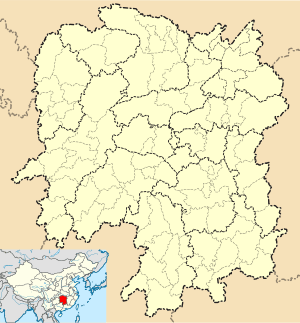
.svg.png)



